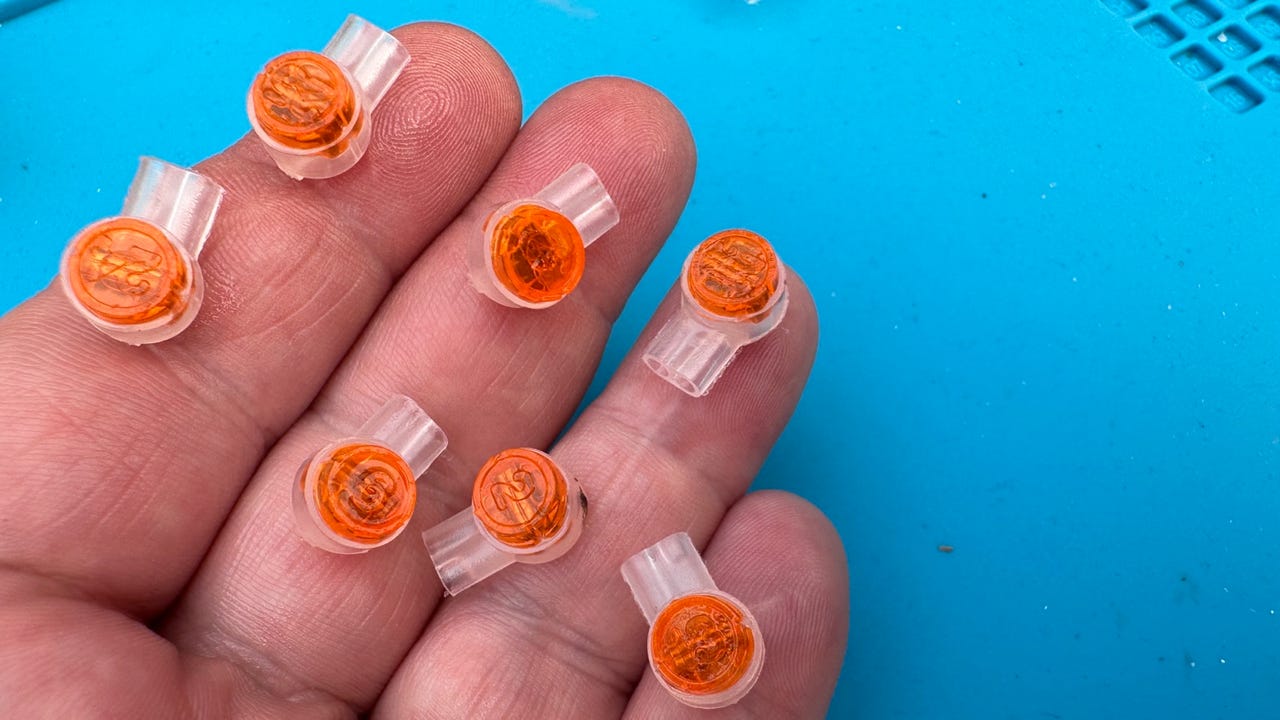
































Jelly crimps galore!
Adrian Kingsley-Hughes/Regular readers will know that I love the Wago lever nuts for making solid, reliable connections in domestic mains voltage wiring. But another connector I find myself using a lot is the jelly crimp. In fact, I used some today to fix some broken wires in a doorbell.
Jelly crimps are the mainstay of telecom installations and repair (at least here in the U.K.). I was introduced to them many years ago by an engineer who gave me a handful of them, and ever since I've been hooked.
Also:How to strip wires like a pro (and my must-have tools)
These connectors come under lots of different names, but jelly crimps is what they are best known as.
A pack of splice connectors that provide a water-resistant adhesive atop cables.
View at AmazonThe "jelly" bit in the name comes from the fact that the ends are packed with a dielectric silicone sealant that both adds extra insulation and also makes the connection weatherproof.
They come in two-way (called UY) or three-way configurations (called UR), depending on whether you want to connect two or three wires together, and they have been specifically designed for joining solid-core copper or aluminum telephone and communications wires.
Also: How to use heat-shrink butt connectors to fix broken wires
Along with the UY and UR configuration differences, there are also different sizes depending on the outer diameter of the wire you're going to be connecting using the jelly crimp. Regular UR and UY are for thinner 22-26 awg wires with an insulation outer diameter of 1.52mm, while the UY2 and UR2 sizes accommodate the thicker 19-26 awg wires with a maximum insulation outer diameter of 2.08mm.
A UY2 jelly crimp that's oozing a bit of the silicone gel onto my hands
Adrian Kingsley-Hughes/You'll find lots of different brands out there, and they can be hit and miss, and I've seen cheap ones fall apart or not contain any gel. I have a source in the telecom business that keeps me supplied, but if you're having to buy them online, I recommend going for the 3M Scotchlok brand.
I find the two-way ones to be the most useful, with a 100 pack of UY and a100-pack of UY2 being enough to cater to my needs.
The crimp is filled with a non-conductive jelly that waterproofs the joint
Adrian Kingsley-Hughes/They're dead easy to use.
You cut the cable, poke the ends in all the way (no need to strip the insulation), and squeeze the button to snap them down and bite through the cable.
That easy!
Their primary use is on telephone wiring, but I've also used them on alarm systems, doorbells, speakers, and other low-voltage applications. These connectors can handle up to 50V, so don't use them on mains voltage in case someone -- possibly you -- dies.
Jelly crimps are great for low voltage applications, here carrying 12V to a fan
Adrian Kingsley-Hughes/The connections are highly reliable, and as long as they aren't submerged in water, they will last for decades (and even submerged ones have a long life, in my experience).
Squeezing a jelly crimp with a Knipex waterpump pliers
Adrian Kingsley-Hughes/There is aspecial tool for doing the squeezing that you can pick up for$15 . If you crimp a lot then this might make sense, but I find I can use my finger and thumb, or a pair of Knipex mini waterpump pliers to do the job.
A fully crimped jelly crimp
Adrian Kingsley-Hughes/Did I mention that they are incredibly satisfying to "pop"?
POP!
Adrian Kingsley-Hughes/ Tags quentes :
Tecnologia
Nosso processo
Hardware
Tags quentes :
Tecnologia
Nosso processo
Hardware